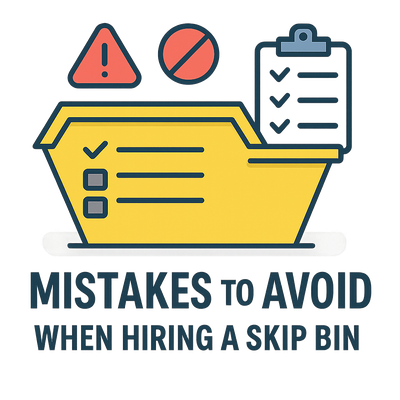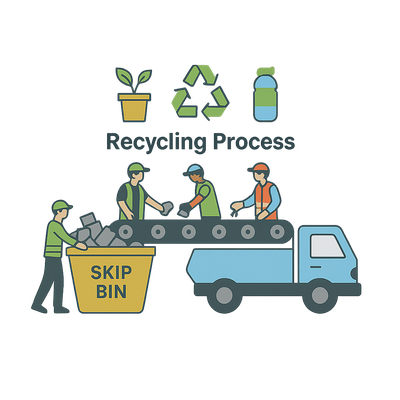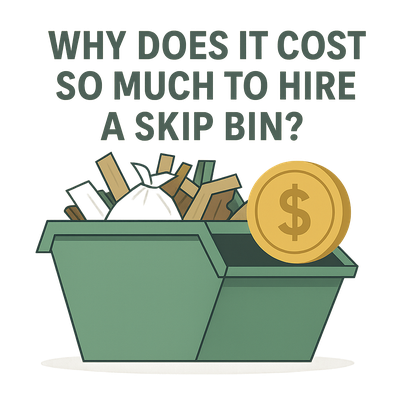
By Brimbank Bin Hire - August 2025
Hiring a skip bin is a smart way to manage waste from renovations, clean-outs or business projects. But one key question many customers overlook is: where should the skip bin be placed? The answer affects cost, accessibility, safety, permit requirements and the smooth delivery and collection of the bin. Planning your placement early ensures your job stays on schedule and avoids unexpected fees or delays.
Selecting the Best Spot on Private Property
For homeowners and business sites alike, placing a skip bin on private-property (such as a driveway, yard or cleared area of your site) offers the simplest solution. Skip bins on private land typically do not require a council permit, provided access is sufficient and you're not obstructing neighbours or public footpaths.
When choosing a spot, check the width of the driveway or access path, skip trucks may need around 2.5 to 3 metres of clearance to deliver and remove the bin safely. Avoid placing the bin under low branches, overhead cables or on uneven ground. Also consider how waste will be carried to the bin: placing the bin close to the work area reduces time, effort and risk.
When Placement on Public Land Is Necessary
If your property lacks space for the bin, such as narrow front yards, shared driveways or apartment sites, you may need to place the skip on public land (roadway, nature strip or footpath). In that case you'll usually require a council permit. This adds complexity and cost, so it's important to plan ahead and confirm which council area you are dealing with.
Public land placement must leave safe foot and vehicle access. Local laws may require a minimum clear width for pedestrians (commonly 1.5 – 3 metres) or vehicles, and the skip must not block fire hydrants, driveways, public utilities or cause hazards.
Access and Delivery Considerations
Before the skip arrives take a moment to clear the zone and ensure unobstructed access. The truck will need room to position itself and deploy the skip, so make sure nothing is blocking gates, parked cars or vegetation. If you're on a slope, compacted surface or soft lawn, request protective planks or mats from your provider to avoid ground damage.
Remember: the skip bin remains at your site until collection. Avoid placing it where other trades, vehicles or pedestrians will need to cross repeatedly. A well-planned delivery zone reduces potential delays or relocation fees.
Driving Safety & Neighbour Considerations
Skip bins and delivery trucks can create potential hazards if not properly managed. For placements near roads or driveways consider adding reflective signage or traffic cones to alert drivers. Avoid placing the bin where it obstructs sightlines for vehicles exiting driveways or blocks pedestrian pathways.
“A neatly positioned skip bin keeps your project moving, protects your property and minimises disruption to neighbours.”
Permit Requirements and Duration
In many cases, no permit is needed if the skip stays wholly on your private property. However, as soon as the bin is placed on public land you may need a permit, often arranged by the skip hire company or by you in consultation with the council. Duration and cost of permits vary between local government areas and may include application fees, placement fees and time limits.
Be mindful of how long you plan to keep the bin. Some permits cover one week, others extend to longer periods. If your project runs past the approved time you may incur penalties or need to apply for an extension.
Surface Compatibility and Site Preparation
Hard surfaces such as concrete or paved driveways are ideal for skip bin placement. On softer ground such as lawn or gravel, the weight of the skip and collected waste may cause damage or uneven settling. Ask your provider if they can supply timber boards or mats to distribute the load and protect the surface.
Also clear the area of low tree branches, overhead wires and garden features like trellises or irrigation lines. Ensure the bin will sit level and that the truck can deliver without reversing long distances or navigating narrow lanes.
Waste Flow and Project Efficiency
Where the bin is located impacts how easily your site can access it. Place the skip as close to the work area as reasonably possible. For example, if you're clearing a back yard, placing the bin at the rear may cost more due to access logistics. Conversely, placing the bin where the bulk of the waste will be generated, garage, kitchen, garden, improves efficiency and reduces manual transport of waste.
Business Site Placement Tips
Commercial or industrial sites introduce special concerns: parking bays, shared driveways, pedestrian walkways and neighbouring businesses all affect placement. On these sites you may need clear signage, cones, protective bollards and possibly traffic management. If the bin is placed on a site used by other tenants, ensure you coordinate with others so that operations continue smoothly.
Look at available space early and book your bin with your provider and traffic management team as part of your project planning.
“Smart placement isn't just about location, it's about minimising cost, avoiding delays and staying compliant with regulations.”
Checklist for Perfect Placement
- Is the area flat, stable and capable of supporting the bin and truck?
- Can the delivery truck access the spot without reversing excessively or hitting obstacles?
- Will placement interfere with pedestrian paths, neighbour driveways or public utilities?
- If the bin is on public land, has a permit been obtained and does the duration match the hire period?
- Have you sorted access rights, gate clearance and time restrictions (like peak hour no-stop zones)?
- Is the skip close to where most waste will be generated to reduce labour and manual transport?
“We ensure your skip bin sits in the right spot, stays compliant and supports your project with zero hassle.”
How Can We Help You?
We at Brimbank Bin Hire guide you through every step: selecting the right location, checking surface and access, advising on permits and managing delivery and collection logistics. We work with you to ensure skip placement is convenient, compliant and cost-efficient so your project stays on track and disruption is minimised.
 Brimbank Bin Hire
Brimbank Bin Hire

